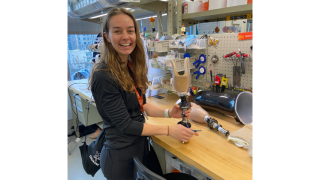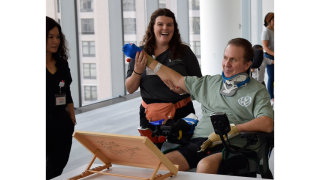Body
The following information will help you to use and take care of your prosthesis.
Donning (putting the prosthesis on) and Doffing (taking the prosthesis off):
- Before donning, inspect your limb to make sure there are no areas of redness or abrasion.
- Each time you remove the prosthesis, examine your residual limb for areas of excessive redness, irritation, or swelling. Check your skin with your eyes and with your hands (especially if you have altered sensation from neuropathy, poor circulation, or diabetes). If redness does not go away within 15 to 20 minutes, discontinue use and contact your prosthetist or physician.
- If your prosthesis causes pain or discomfort, check the following:
- Check to be sure the prosthesis is properly positioned on your residual limb. Is it rotated? Use your kneecap (if you have a below-knee amputation) or your sit bone (if you have an above-knee amputation) as landmarks to tell whether the socket is properly positioned.
- Check to be sure you are wearing the correct number of socks. Did you try adding or removing a sock? Sock ply may change dramatically during the first few weeks of wear, especially if this is your first prosthesis. Many people find it necessary to add or remove a sock during the day.
- Consider your wearing schedule. Did you wear it too long?
- Here are a few helpful hints for donning (putting on) various types of prostheses:
- Gel liner: Turn liner inside out and make sure bottom is flat, with no air space at the bottom, before you roll it onto your limb. A below-knee liner is cut straight at the top. An above-knee liner is slanted at the top, with the shorter side on the inside of your thigh and the longer side on the outside of your hip. If your liner has a pin at the bottom, make sure the pin points straight out from the bottom of your residual limb and is not tilted forward or to the side. If you have trouble getting the pin to lock, try taking the liner off and put it on again, taking care to line the pin up straight. If you wear a seal-in liner, be sure that the seal lays flat before putting the prosthesis on. If you wear socks with your seal-in liner, be sure the socks are tucked under the seal and do not cover the seal.
- Socks: At the beginning of each day and throughout the day, be sure to check whether you are wearing the right number of socks. If you are not wearing enough socks, you may feel too much pressure at the very bottom of your limb and you may feel that you are sinking in too far. If you are wearing too many socks, you may feel that your limb is too high in the socket and there is space between the end of your limb and the bottom of the socket. You may also see a purplish color at the bottom of your limb after you take the prosthesis off. Try removing a sock or notify your prosthetist if you are already wearing as few socks as possible. Be sure that your limb always touches the bottom of the socket – there should not be any air space below your limb.
- Valve: If your prosthesis has a valve that screws in and out of the socket, be sure to check the valve hole each time you put the prosthesis on. Put one finger through the valve and be sure that your limb completely touches the valve opening. You should not be able to fit your finger into the socket or under your residual limb when your limb is donned properly.
- Sleeve: If your prosthesis has a knee sleeve that goes up onto your thigh, be sure the gel material touches your skin. You may have to shorten your socks or fold the top of your sock down if the sleeve does not contact your skin.
- Belt: If you wear a belt to hold your prosthesis on, be sure the belt is tightened securely around your hips and be sure that the prosthesis is rotated properly before securing the belt.
Wearing your Prosthesis:
- Wean into the prosthesis for the first few days, slowly increasing the number of hours worn each day. It is important to allow your residual limb time to accommodate to your new prosthesis. Avoid very strenuous activity during the first week to ensure a comfortable transition to your new prosthesis.
- A sample wearing schedule is as follows. If you notice redness, irritation, blisters, or wounds, discontinue wear and contact your prosthetist or physician.
- Day 1: Wear the prosthesis for 1 hour
- Day 2: Wear the prosthesis for 2 hours
- Day 3: Wear the prosthesis for 4 hours
- Day 4: Wear the prosthesis for 8 hours
- Day 5: Wear the prosthesis all day, putting it on when you get dressed in the morning and taking it off when you are ready to go to bed.
- Remove prosthesis and inspect your limb at each break.
- Do not attempt to use the prosthesis independently until directed by your physician or therapist.
- Follow the safety precautions that your prosthetist and therapist have given you. You may need to use a walker or cane when you are learning to walk with the prosthesis. Be aware of changes in surface when you are walking. The transition from smooth tile floors to rough carpet can cause you to stumble if you are unaware of the change.
- Any changes in activity level will affect the function of the prosthesis. If your activity level changes (for example, you are progressing through your initial gait training with your therapist), contact your prosthetist for a recheck of the alignment and function of the prosthesis.
- The prosthesis is for use in normal conditions and environments. Avoid water, high impact activities, or contact with corrosive chemicals.
- Always wear a shoe with your prosthesis. Walking without a shoe may cause you to feel like you are falling backward. You can change shoes, but be sure that they have the same heel height as the shoes you wore to your appointments with your prosthetist. If you are unsure if shoes have the same heel height, call and make an appointment with your prosthetist to have them evaluated.
Caring for your Residual Limb:
- Wash your residual limb daily with a mild soap and water, rinse and dry carefully. Do not soak as this makes the skin tender. The best time to cleanse your residual limb is at night. Your residual limb must be thoroughly dry before putting on your prosthesis. If you perspire excessively during the day, remove your prosthesis and pat your limb dry, changing socks if needed. Discontinue wearing your prosthesis while waiting for a breakdown or abrasion to heal. Report any concerns to your prosthetist or treating physician.
- Do not shave your residual limb or apply lotions or moisturizers to your residual limb, unless instructed by your prosthetist or treating physician.
- Any changes in body weight may alter the fit of the prosthesis. If your weight changes, make an appointment with your prosthetist or physician to have the fit evaluated.
Caring for your Prosthesis:
- Socket: For optimum function clean the interior of the socket every day. Use a sponge or soft cloth and a little mild soap. Remove soap residue with a sponge or cloth flushed with clear water. Your prosthesis should not be submerged in water. Let dry overnight. Clean the exterior the same way when needed. If your prosthesis develops an odor, speak with your prosthetist to be sure you are cleaning your device and your limb as best as possible.
- Gel Liner: Wash your liner every evening according to the manufacturer’s instructions and put on a clean liner each morning. You should have two liners so that one may be washed while the other is worn. Gel liners, socks, and sleeves should normally be replenished every 6-12 months for proper hygiene and function.
- Socks: Put on clean socks every day and wash soiled socks according to the manufacturer’s instructions. The sock must fit snugly, without wrinkles, to avoid pressure points on your residual limb.
- Suspension Sleeve: Be careful when donning the sleeve to not puncture it with a finger or finger nail. The sleeve can be rolled down and hand washed weekly with mild soap. Rinse the sleeve well; soap residue may cause irritation to the skin. Allow the sleeve to air dry. The sleeve may slide down on the socket over time. Be sure that a few inches of gel material are always contacting your skin when you put on your prosthesis.
- Mechanical Parts / Components: Schedule a recheck appointment with your prosthetist at least once per year to ensure optimal function. Do not adjust screws, joints or other parts yourself. If you hear any unusual noise such as clicking, grinding or cracking, discontinue use and contact your prosthetist. Report any black or metallic dust to your prosthetist.
Please don’t hesitate to contact us if you have any questions or concerns about your prosthesis. We are happy to be working with you! You may send us a secure message through the Shirley Ryan AbilityLab Patient Portal online, or you may call Shirley Ryan AbilityLab at 312-238-1000 to schedule an appointment or ask for your prosthetist’s clinical voicemail box to leave a voicemail message. Our office hours are Monday through Friday 7:30am – 4pm.



